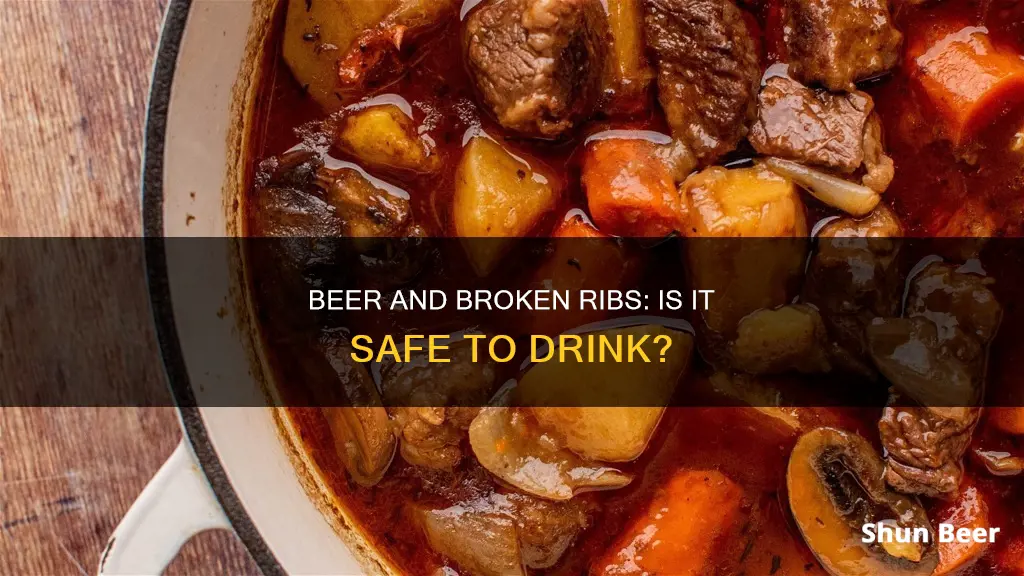
Drinking beer or any alcoholic beverage when you have broken ribs is not recommended. Alcohol use disorder (AUD) has been associated with an increased risk of adverse outcomes in patients with rib fractures. Chronic and heavy alcohol consumption can negatively impact bone healing and repair by interfering with the production of new bone cells and affecting the bone matrix. Additionally, alcohol can impair your judgment and increase the risk of tripping or falling, which could lead to reinjuring your broken ribs. While moderate alcohol consumption may have potential health benefits, it is best to consult with your physician about the appropriate level of alcohol consumption, especially when recovering from an injury.
| Characteristics | Values |
|---|---|
| Can I drink beer with broken ribs? | It is not recommended to drink beer or alcohol when you have broken ribs as it may affect bone healing. |
| Beer's effect on bone health | Beer contains silicon, a mineral needed to build new bone mass and connective tissue. However, excessive alcohol consumption can affect bone healing by interfering with the production of new bone cells and impairing vitamin absorption. |
| Alcohol use disorder and broken ribs | Studies have shown that patients with alcohol use disorder and rib fractures had higher rates of adverse events such as pneumonia, unplanned intubation, sepsis, acute respiratory distress syndrome, and mortality. |
| Bone healing | The body needs time and the right mix of nutrients to generate healthy and strong bone cells. Alcohol can affect the body's ability to produce new bone cells and may slow down bone healing. |
What You'll Learn
- Beer contains silicon, a mineral required for new bone mass
- Heavy drinking may slow bone healing
- Alcohol affects the body's ability to produce new bone cells
- Alcohol may increase the risk of falling and re-injuring broken ribs
- Alcohol may affect the production of hormones and vitamins required for bone health

Beer contains silicon, a mineral required for new bone mass
While it is not recommended to drink beer or any alcoholic beverage in excess, especially when recovering from an injury like broken ribs, beer does contain silicon, a mineral required for new bone mass. Silicon is a key ingredient for increasing bone mineral density and preventing osteoporosis, a disease of the skeletal system characterised by low bone mass and deterioration of bone tissue.
Beer is a significant source of dietary silicon, which is present in the beverage in the soluble form of orthosilicic acid (OSA). This yields 50% bioavailability, making beer a major contributor to silicon intake in the Western diet. The National Institutes of Health (NIH) states that dietary silicon, as soluble OSA, may be important for the growth and development of bone and connective tissue.
The amount of silicon in beer varies depending on the type of beer and the brewing process. Researchers at the University of California, Davis, found that the average beer contains 29.4 parts per million (ppm) of silicon, with India Pale Ales (IPAs) having the highest amount at 41.2 ppm. Ales average 32.8 ppm, while lagers are around 20 ppm. Beers containing high levels of malted barley and hops, such as IPAs, are richest in silicon. Pale beers also tend to have higher amounts of silicon as they receive less damaging heat during the malting process than darker beers.
The silicon content in beer comes primarily from the malted barley or wheat used in the brewing process. Barley contains higher levels of silicon than wheat, and the majority of the silicon is found in the husk, which is retained during brewing. While most of the silicon remains in the spent grains, aggressive treatment during wort production can increase the extraction of silicon into the wort, which then survives into the final beer product.
Exploring the Legal Drinking Age: Beer and the Law
You may want to see also

Heavy drinking may slow bone healing
Alcohol affects the bone matrix production by interfering with signals from your injured bone to the brain to signal the need to build new bone cells. The more alcohol consumed, the more affected the ossifiable matrix can be. Alcohol can also cause problems with your bones getting the vitamins they need to stay healthy. These vitamins include calcium and vitamin D. Even if you take a daily vitamin, your body may not be able to use and process these vitamins as well if you are using alcohol heavily. With heavy alcohol use, your bones are not getting the building blocks they need to grow.
Heavy drinking can prevent bones from being formed when someone is young. Younger people who engage in heavy drinking do not make as much bone as those who do not. Studies have shown that heavy alcohol use means that older people also lose more bone more quickly than people who do not drink alcohol. Regardless of age, alcohol can harm your bones. Heavy drinking is known to put you at high risk of developing osteoporosis. When bones become less dense, you may develop osteoporosis. This disease has no symptoms, but your bones become more fragile. If you fall, you can break a bone more easily than normal.
Walking and Drinking Beer Legally in Venice
You may want to see also

Alcohol affects the body's ability to produce new bone cells
Alcohol can also affect the hormones that regulate calcium metabolism, such as steroid reproductive hormones and growth hormones. This, in turn, can affect bone health. In addition, alcohol can decrease the body's ability to absorb calcium, which is essential for healthy bones.
The effects of alcohol on bone health are influenced by age and drinking pattern. Moderate alcohol consumption may have neutral or beneficial effects, resulting in higher bone mineral density and reduced age-related bone loss. However, heavy alcohol consumption is generally associated with decreased bone mineral density and increased fracture risk.
The specific effects of alcohol on bone health are complex and not yet fully understood. Further research is needed to determine the precise mechanisms by which alcohol affects bone metabolism and to establish the impact of drinking on bone health in younger individuals.
The Magic of Beer Randall: Infusing Beers with Flavors
You may want to see also

Alcohol may increase the risk of falling and re-injuring broken ribs
Alcohol consumption can increase the risk of falling and re-injuring broken ribs. Drinking excessively impairs judgement and makes it easier to trip and fall, which could lead to further injury. Spine and hip fractures are more common in people who struggle with alcohol abuse, as drunk individuals do not have the same balance and gait as sober people.
Alcohol also affects the body's ability to produce new bone cells, which are essential for healing. It can interfere with signals from the injured bone to the brain, indicating the need to build new bone cells. The more alcohol consumed, the greater the impact on bone cell production.
Additionally, alcohol can cause bone weakening and breakage by disrupting hormone production and regulation, as well as vitamin absorption. It can increase cortisol levels, which can harm bones, and impair the production of testosterone and estrogen, which are important for bone growth. Alcohol can also hinder the absorption of vitamins like calcium and vitamin D, which are necessary for bone health.
Therefore, it is advisable to refrain from alcohol consumption while recovering from broken ribs to reduce the risk of re-injury and promote optimal healing.
Drinking Beer in Public: Michigan's Law Simplified
You may want to see also

Alcohol may affect the production of hormones and vitamins required for bone health
Alcohol can affect the production of hormones and vitamins required for bone health. Alcohol abuse can result in clinical abnormalities of the endocrine system, which is one of the body's most important systems. The endocrine system includes the hypothalamic-pituitary-adrenal axis, the hypothalamic-pituitary-gonadal axis, the hypothalamic-pituitary-thyroid axis, the hypothalamic-pituitary-growth hormone/insulin-like growth factor-1 axis, and the hypothalamic-posterior pituitary axis. These systems work together to maintain a constant internal environment and respond to changes in the body's internal and external environments.
Chronic alcohol consumption can interfere with the production and function of hormones such as testosterone, estrogen, and growth hormones. This can lead to reduced libido, infertility, and gonadal atrophy. Alcohol can also affect calcium metabolism and bone structure by altering reproductive hormones, causing parathyroid hormone deficiency, and inhibiting the activity of bone-forming cells. Additionally, alcohol can increase the body's production of cortisol, which can adversely impact bone growth in the long term.
Overall, alcohol's effects on the endocrine system and hormone production can have serious consequences for bone health and increase the risk of osteoporosis.
The Magic of Mr. Beer Kit: Brewing Simplified
You may want to see also
Frequently asked questions
It is not recommended that you drink beer or any other alcoholic beverage if you have broken ribs. Alcohol use disorder (AUD) has been linked to an increased risk of adverse outcomes in patients with rib fractures.
Drinking beer or other alcoholic beverages with broken ribs can lead to several complications, including impaired judgment, which can increase the risk of tripping or falling and re-injuring your ribs. Alcohol consumption can also interfere with the body's ability to produce new bone cells, potentially slowing down the healing process.
Alcohol can interfere with the production of osteoblasts, which are new bone cells that the body needs to build after a bone fracture. It can also disrupt the production of the ossifiable matrix, a group of bone cells that harden following a fracture.
Beer contains silicon, a mineral needed for building new bone mass and connective tissue. However, the link between drinking beer and improved bone health has not been definitively established. It's important to note that excessive alcohol consumption can have damaging effects on the body.
If you find yourself unable to give up daily or excessive beer consumption, it may be a sign of AUD. AUD is associated with an increased risk of adverse health outcomes and can contribute to reckless behaviour, such as driving under the influence. It's important to seek help from a physician or specialised resources if you think you may have AUD.







